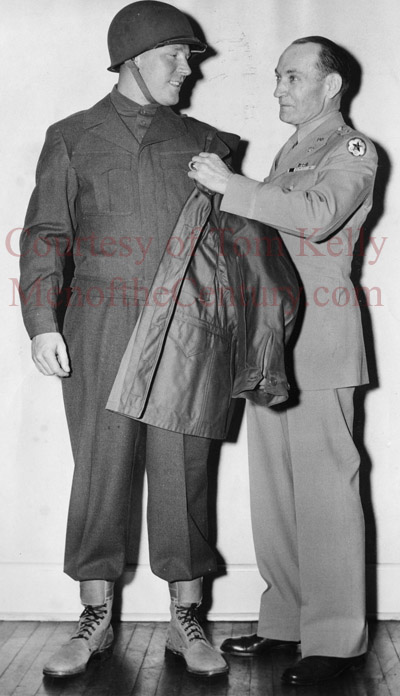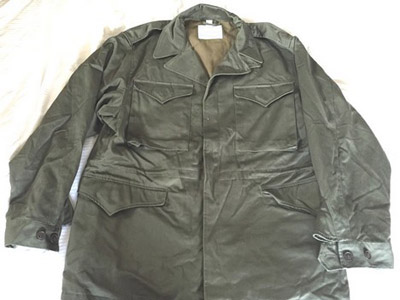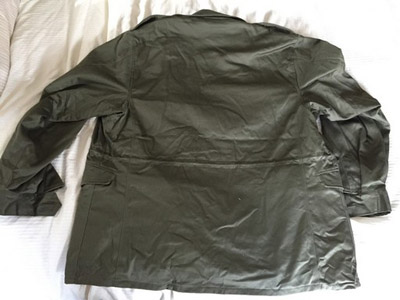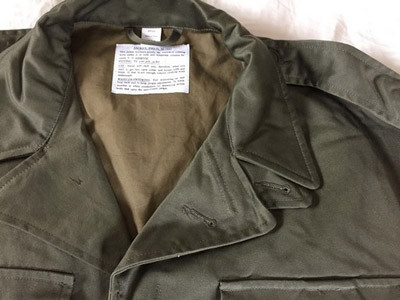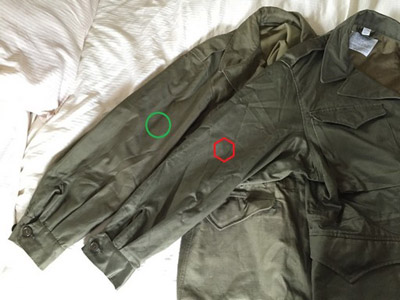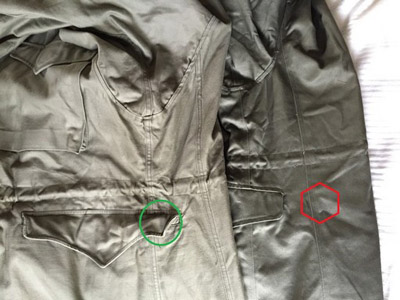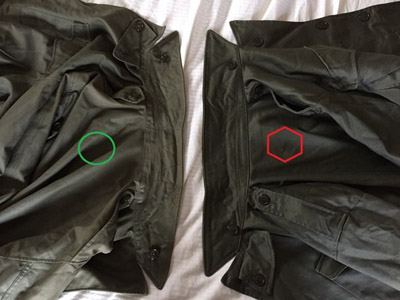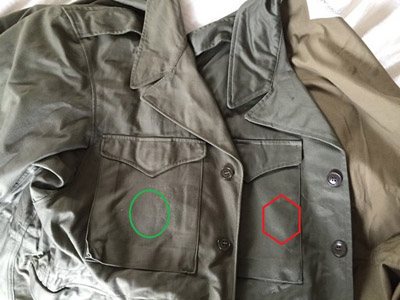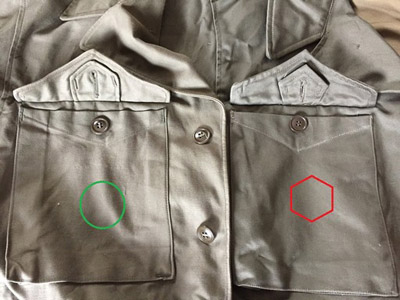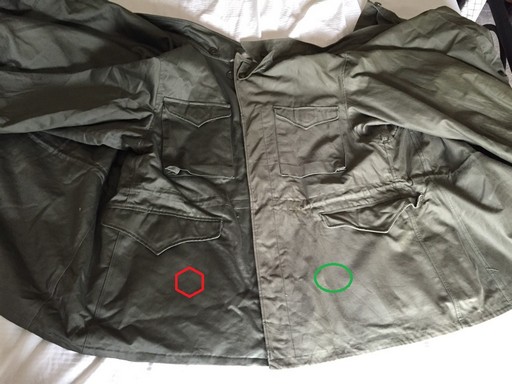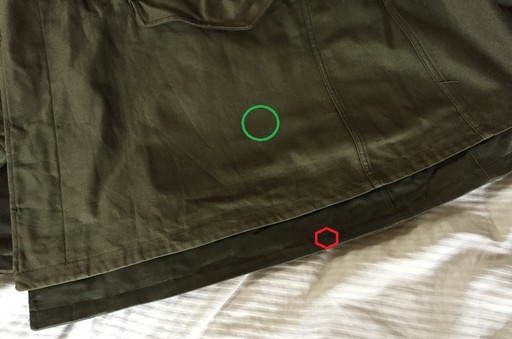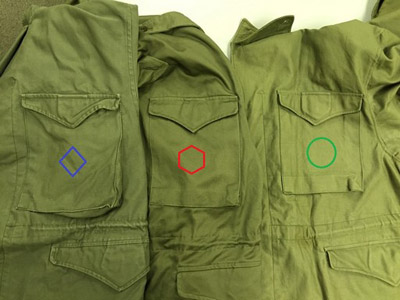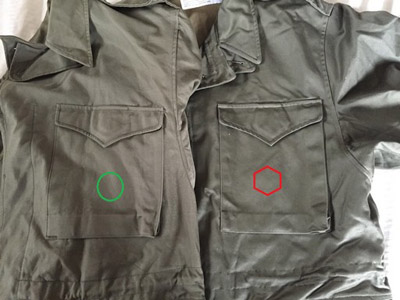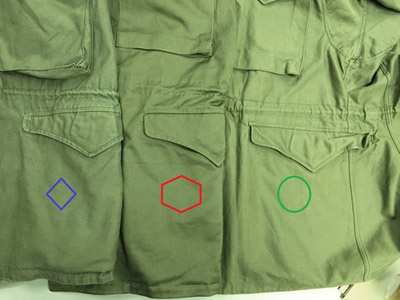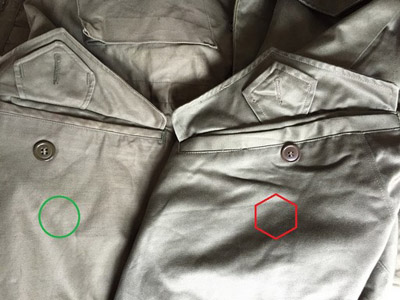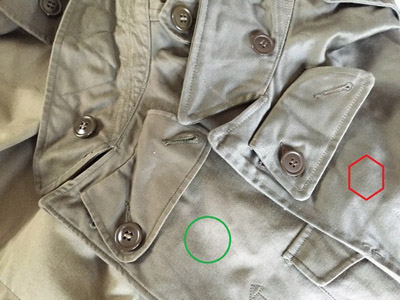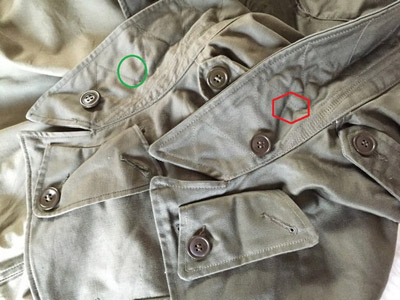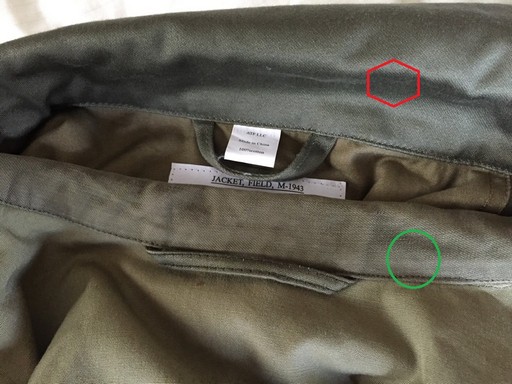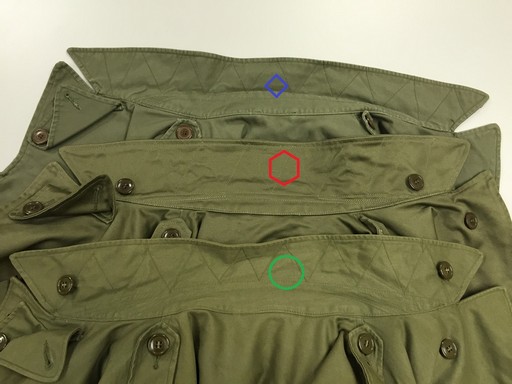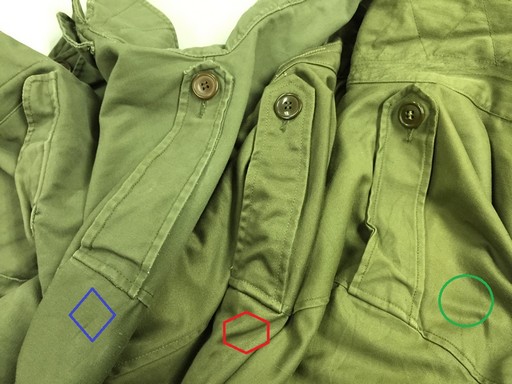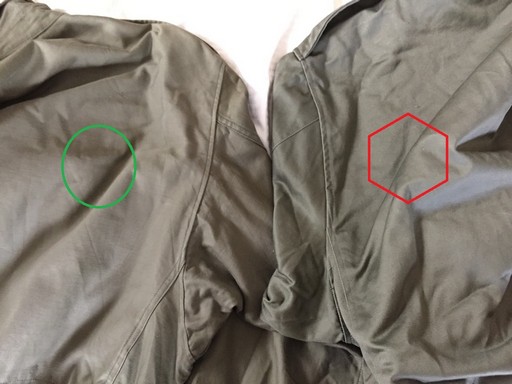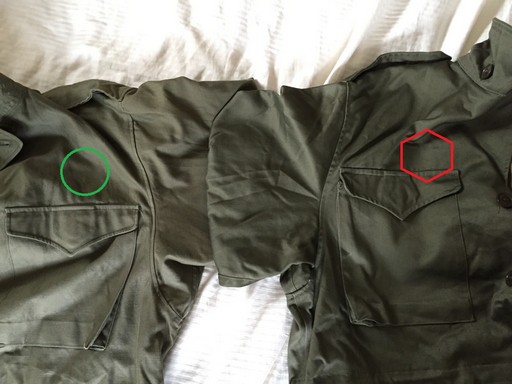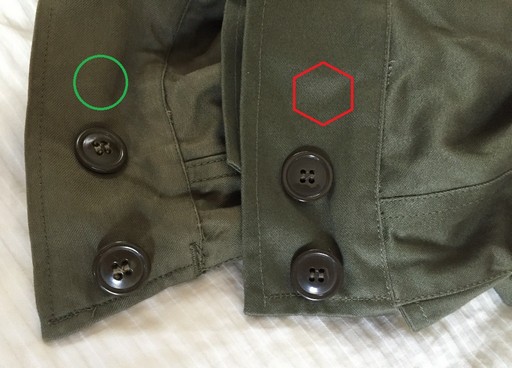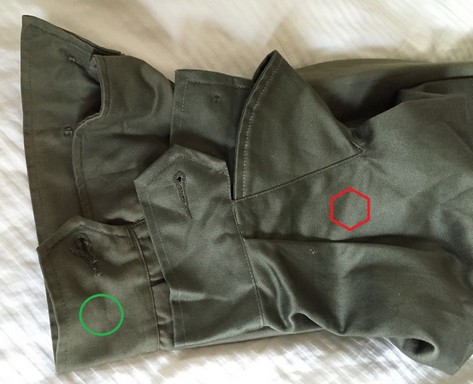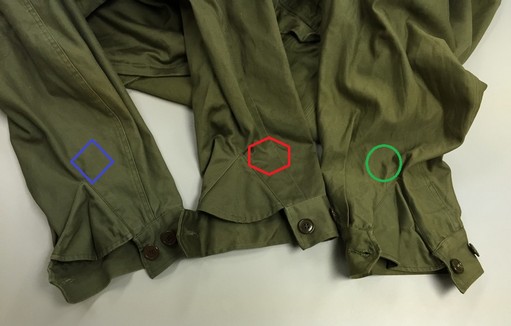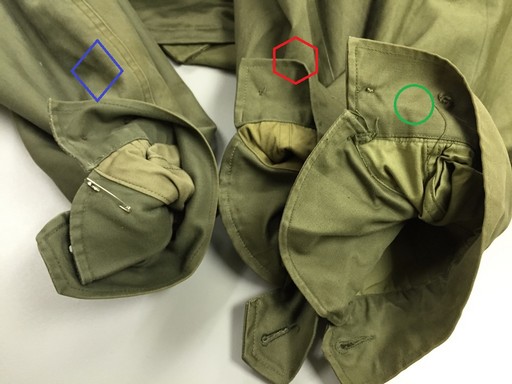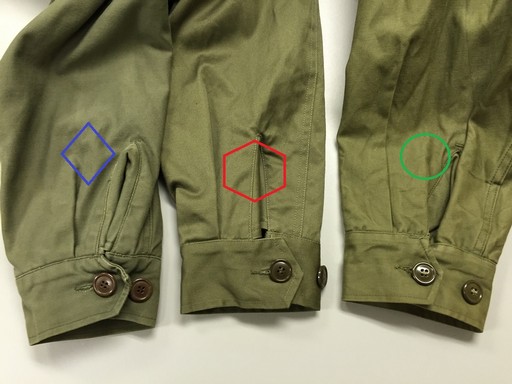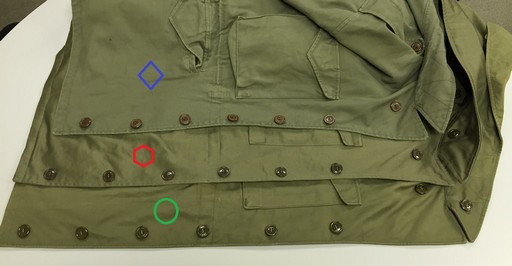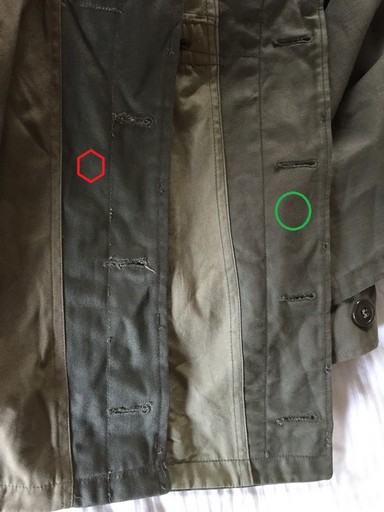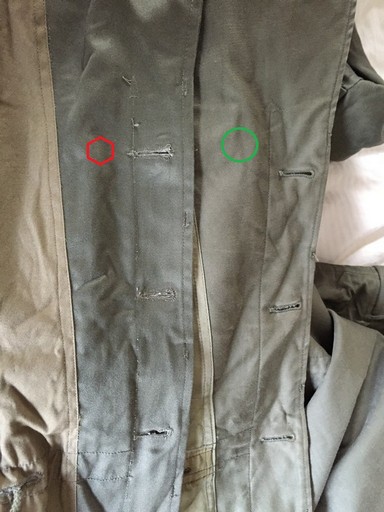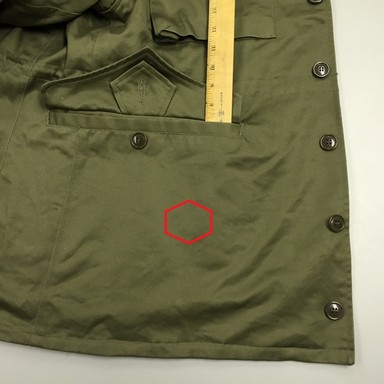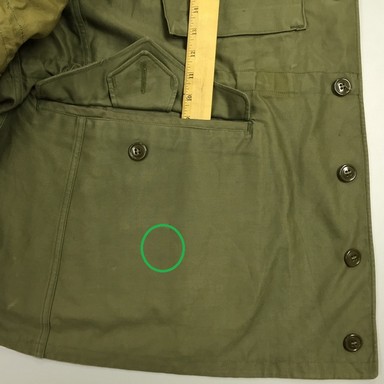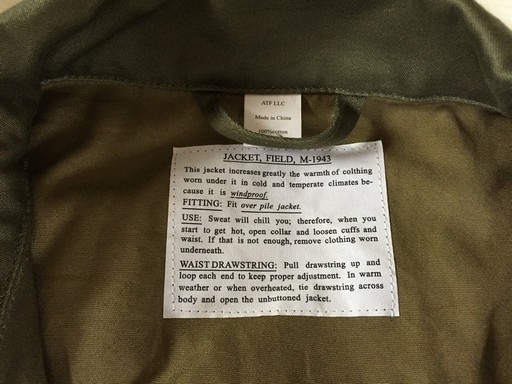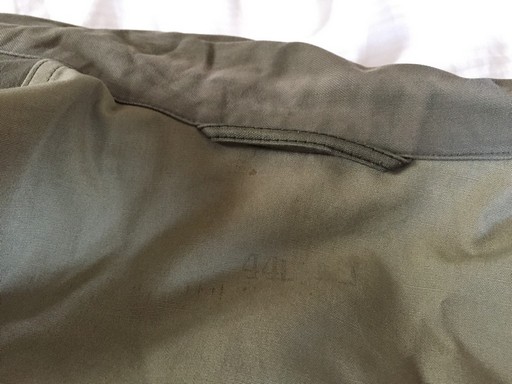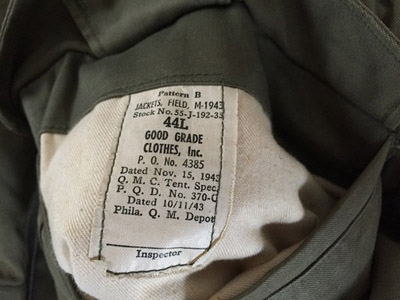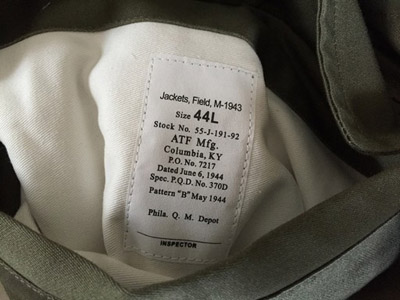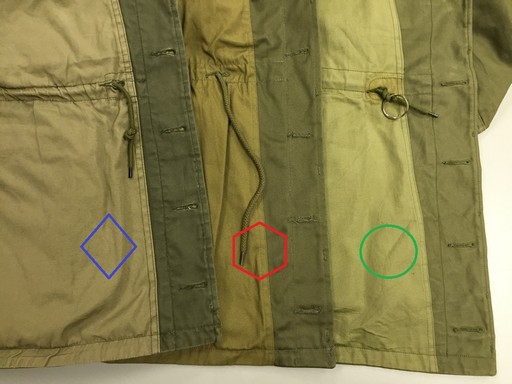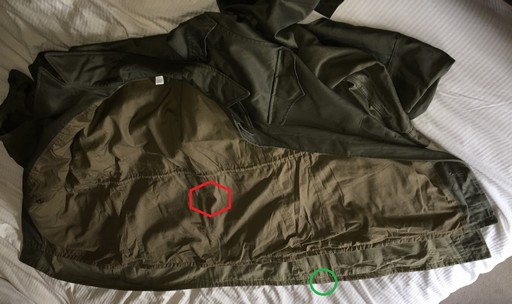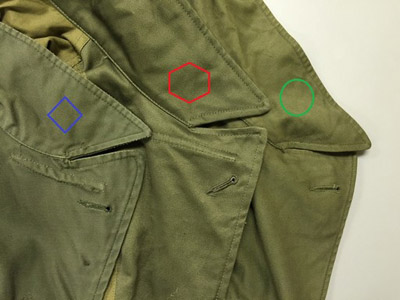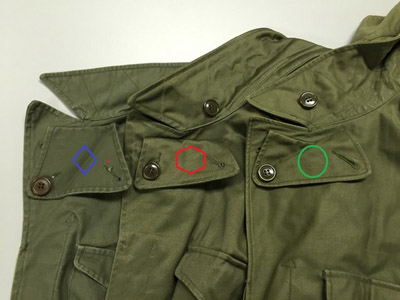At The Front M43 Field Jacket - 2015 Run
Review Date: 6/20/2015
Author: Sean Foster
"1st. Lt. J.F. Bechtold models new Jungle Uniform"
Location: Q.M. Depot Date taken: December 1, 1944 Photographer: Joe Martin Courtesy of the Philadeplhia Inquirer Archive, and Tom Kelly 100th ID
Background:
The M-1943 Field Jacket (Jacket, Field, M-1943) was the result of research and development to adopt an all-purpose uniform that would allow for ease of issue to American military forces. Prior to the adoption of the M-1943, there were specialized uniforms for paratroopers, mountain troops, ski troops, armor crew, etc. The numerous special garments added distinction and sometimes a certain esprit de corps, however the logistics of production, procurement, and issue proved to be an added complication which was not helpful in time of world war and fabric rationing on the homefront. The M43 field jacket was well received by the troops, and many of its foundational design elements remain in use in military field jackets of numerous nationalities to this day.
The M1943 Field Jacket was the primary garment of the layering system which also included the pile liner and field trousers. The garment itself was oversized to allow its wear over the following other garments, given the need: Undershirt, OD wool shirt, sweater, pile liner. As a result, an original marked 38R can often fit someone size 42R or 44R when not being worn over a sweater and pile liner. These were issued in even numbered chest sizes and in varied heights. In personal experience I have seen these ranging in size from 32R to 48L. 36R seems to have been one of the most common sizes produced.
Issue of the M43 field jacket in the ETO seems to become widespread beginning in October 1944 and increasing through the end of the war. Some soldiers in the MTO received these jackets as part of QMC trials in 1943. Once adopted, a deliberate effort was made to have these jackets produced and issued to the soldiers, even though the other garments of the M1943 system (field cap, pile liner, field trousers) were scarce during the war due to the concentrated emphasis on getting the field jacket produced and issued (and also due to decisions of the ranking officers within the QMC). During the Korean War, this field jacket had become the standard field jacket for the Marines as well as the Army. It was subsequently replaced by the M-1951 and later the M-65 field jacket.
Variations exist in originals, as there were a few patterns tested and manufactured. Variants of the M-1943 field jacket may be explained in another article on this website in the future.
Ordering:
Purchase date: April 08, 2015
Delivered: April 10, 2015
Current Retail: June 18, 2015: $124.99
At $125, this is reasonable and not much higher than I paid for my earlier ATF M43 field jacket in 2005. Other vendors sell repro M43 field jackets in the range of $70 to $220, with the more expensive ones being made in the USA. When looking at the garment from an apparel design and construction standpoint, it is my honest opinion that it could not be manufactured in the USA for the price ATF is selling it for (and indeed, this garment is made in China). The design is a complex one to manufacture when compared with other field jackets like the M1941 or the tanker jacket. This is an important consideration to factor, as the jacket has many sewn seams and more cut fabric pieces used in its assembly than the Winter Combat Jacket, or M1941 Field Jacket.
About the Comparison:
Size purchased: 44L
Original size: 44L
* In some images I have also included a 2005 production ATF repro M43 field jacket, size "L"*
An earlier review of the 2012 production M-1943 Field Jacket from At The Front can be found at this link.
The 2005 production ATF repro M43 is also referenced and compared in this article, as that was the first M43 offered by At The Front, and until now had been the benchmark from which to compare the newer ATF repros.
Materials:
Both the shell fabric and the lining material compare well to originals. The fabric is tightly woven cotton, as it should be. I have no objections concerning the cloth materials used. The buttons are not exact copies, but they are reasonably close. The lining color is also a good match for the early production M43 jackets.
Sizes:
These are made in even numbered sizes (40, 42, 44, etc) which is how the originals were made and issued. Some sizes are available in “L” Long (tall) and “S” Short height, although not every chest size is offered in the Long and Short lengths. Older ATF repros (like the one I use in some comparison images below) were made in size ranges (Medium, Large, X-Large, etc) which is not how originals were sized.
Patterning:
This is an improved garment from the 2012 offering from At The Front. The jacket compares favorably against an original of the same size. Minor differences can be noticed, which will be explained in detail in this article.
The dimensions of the original 44L and this repro 44L are almost identical. Minor differences exist, but a close comparison to the original is necessary to see them. The bottom edge of the jacket is longer in horizontal length in the repro, but only by around an inch. This will not be noticeable when worn.Pocket flaps vary slightly, but not excessively. The dimensional variance is possible to overlook in light of the necessities of production and contractor variations during the wartime garment production
There is a great improvement in the collar of this repro, when compared to the 2012 production. The collar is now more similar in size and shape to the original, and the small storm flap which secured the throat when the collar is worn up is much smaller (and therefore more like originals).
The hanging loop is more open in the repro, and in contrast is more parallel to the collar seam in the original.
Underneath the collar, the reinforcement stitching closely resembles the original.
The epaulettes are similar to the original, although in this repro they appear slightly shorter in the repro than the original. The original and the current repro both have shorter epaulettes than the 2005 repro.
Armholes are shaped similar to the original. This will result in a better vintage fit in the sleeves.
The cuffs differ slightly from this and other originals.
The cuff band itself should have a pointed end on the side with the buttons. On the repro, it is squared off.
Also the end of the cuff with the button hole extends out about ½” from the pleat. Some originals were made in this fashion, whereas others were made with the end of the cuff lining up with the pleat.
There is an arc of material inside the cuff split of the M-1943 field jacket. This fabric extends down into the cuff slightly, and in some variants it will extend to the bottom edge of the cuff itself. On this repro (and on the 2005 repro) this ‘gas flap’ needs to extend down further than it does, at least 3/8” below the top of the cuff band in order to prevent it from popping out. I have to secure these with safety pins (see image and look at the 2005 jacket).
I realize this is a detail which would add considerably to manufacturing time if it were made in accordance with the originals. The thicker layers of fabric require stronger machines to sew, and even then there is an increased chance of needle breakage during sewing.
Button spacing is similar to the original.
The fly front has bartack stitches to keep it flat and closed and protect the buttons (and prevent buttons from catching on brush etc). The bartack stitches on the repro are the usual length of about 3/8 to 1/2 inch. The original ones are much smaller, about 3/16 to 1/4 inch, and this means the original is easier to button as there is more space allowed to get your fingers into the fly to button the garment.The lower pockets are shallower than originals, at 7” deep instead of 9” deep. This means the lower pockets will not hold as much as the originals.
Details:
The contract label in the pocket is well done, and the import tags appear to be easily removed. The size tag is in the neck, underneath the import label (Made in China, 100% Cotton). Most originals have a similar cloth tag sewn in the collar seam to designate the size.There is no size tag in the neck, and the original used in this comparison had the size ink-stamped in the collar, not on a cloth tag. Some originals have a cloth tag sewn in the collar seam to designate the size.
The pocket label follows the layout of an original, but is on a sturdier material so as to remain readable after laundering. The stock number is not the same as an original 44L, but this is a minor detail which will escape nearly everyone. If someone digs into your pockets and criticizes the wrong stock number, please sign them up for therapy.
Thread used to secure the buttons is modern thin synthetic, and does not have the thickness of the cotton thread used to secure originals. This is a similar problem to nearly every repro M43 jacket I have personally examined, and can be remedied by some thicker thread and an hour or so of sewing time (which I doubt I will bother to do since when buttoned only the cuff and epaulette buttons show).
Waist draw-cord opening holes lack the reinforcement stitched inside as seen on originals. This makes these opening holes more possible to rip open. On the original there are pieces of leather inside the jacket which help stabilize the openings where the draw cord protrudes. The original used in this comparison shows signs of staining to the lining caused by the leather inside the garment.In images showing the lining, you can see the extra stitching on the original (and the 2005 repro) to secure this reinforcement, which is missing on the new repro. It is possible some originals were made without this, as some contractors made adjustments to speed up deliveries, but this is a subject for further research. Being located inside the garment, this is a detail that is not likely to be noticed.
Original epaulettes cut with a definite front and back, as the long side closest to the rear is longer than the front side. The repro is also cut in this manner (but this was not true in the 2005 and 2012 jackets).
The storm flap is secured on the repro by stitching it through the finished lapel (see visible stitching on lapel face). Originals did not have this stitching visible, as it was secured to the lapel before the lapel face was finished. This same error existed on the 2005 ATF repro. The top buttonhole, located at the corner of the front left lapel, is angled differently in the repro than in the original. This also is a minor difference which most will not notice.
Construction:
The garment is well made and I did not find any missing stitches, or any seams not properly sewn together. Stitching arrangement (single needle seam / double needle seam) is accurately replicated on the repro.
The vertical seams near the back of the lower pockets are sewn inverse of the original, but this is not unusual.
The method of assembling the cuff band and storm flap to the end of the sleeve is done differently than in originals. It was done in this way for obvious reasons (simplifying production and keeping the material thickness manageable for the sewing machines), but the result is a cuff which will need the gas flap pinned to prevent it from popping out of the cuff split.
The garment appears as though it will be durable, my only suggestion for improvement in construction might be to secure the buttons with thicker thread. After wearing the garment (after these photos were taken) to one display event, I experienced no problems and I think the jacket will be a solid companion through many events, both displays and tacticals.
Other repros:
Other repros I have owned I have subsequently sold off, apart from an older (2005) ATF model and a SEMS / STURM made repro (sold a number of years ago by Hessen Antique). I made comparison photos with the 2005 ATF model, as it is the best M43 previously offered by ATF. The SEMS repro (not pictured) was a good repro, although its coloration is not as accurate as the ATF ones. I do not believe WPG has offered an M43 jacket since around the time that ATF introduced their first one in 2004/2005. WWII Impressions offers M-1943 Field Jackets as well, and the last one of those I owned was a very good garment (I subsequently sold it because it was not offered in Long sizes, which fit me better).
Conclusion:
This is the best M-1943 Field Jacket offered by At The Front since 2005-2006. They have corrected most of the errors from the 2012 production run, and the outside appearance of this jacket is greatly improved from the earlier offerings. The main criticisms are:
- Storm flap stitching visible on the front lapel
- Lower pockets not as deep as originals
- Gas flap in cuff does not extend as low as it should
90th IDPG Reviews



